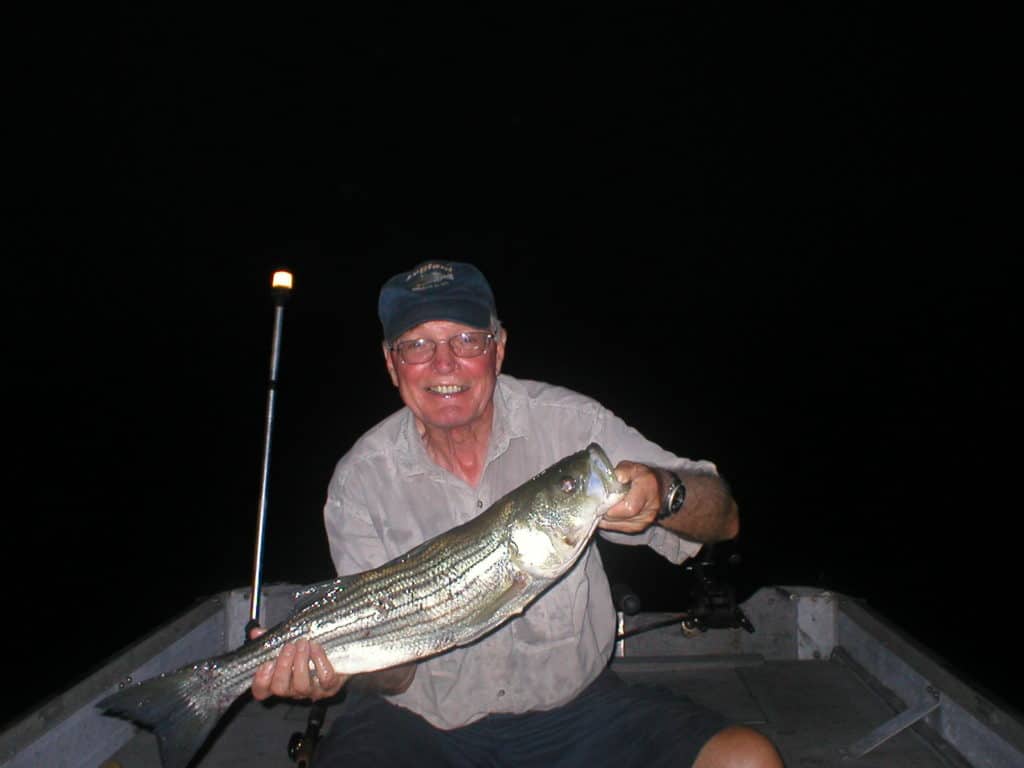Sporting Life

Chasing Stripers in the Dark
By Dennis Doyle
My line hissed through the guides as it shot out in a satisfying cast, low over the barely visible night waters. Throwing about 30 degrees off of the tidal current direction, I was working the submerged end of a long, boulder jetty in about 4 feet of water with a 3/0 sized streamer fly, letting it sink, swing through and straighten out about 70 feet away.
During daylight hours the jetty area always held a good number of small perch scattered around it and as evening fell the little guys moved closer and closer to the big rocks for safety. They were well aware that as visibility faded, striped bass would begin closing in to search for careless youngsters. I was hoping a big rockfish would mistake my streamer for a tasty yearling.
In my distant and far more energetic youth my preference had always been for the 8-weight fly rod with a floating line for night fishing and an all-black bucktail Lefty’s Deceiver streamer that I tied extra bulky. I often tangled with 15 to 20 rock or seatrout during a long, dark evening with not another boat on the water.
In later years, I discovered light, medium action bait casting rigs with a dark Bass Assassin, soft bodied shad threaded onto an eighth ounce jig head or onto a lightly weighted worm hook. I could cover large areas with little effort, slowly and patiently bumping those lures cross current and over the rocky bottoms that bordered the jetties. It was deadly on those same perch-hunting rockfish.
Years after that, I would also begin to revel in using various crankbaits and jerkbaits during the dark on those same lightweight bait casting rigs. I was able to throw the lures greater distances and work larger areas just as effectively. The one thing that always remained constant over the years, however, was that, almost always, I was the only one there.
The memories have faded only a little but the knowledge that the time of year is happening right on schedule remains. The remnants of the deluge of our current tropical storm may slow the event for another week or so but the nighttime action season is upon us.
Getting on site before last light is always a good idea. Locations always look different as the daylight fails and it will take time to get situated just right with the current as you quietly anchor. It will also give you time for a few practice casts to get the rhythm of your fly rod casts just right, or if you’re using spin or casting tackle, just how much effort it takes to hit the sweet spots.
Noise discipline is absolutely necessary. Stripers and seatrout will flush out of any area at the first unnatural sound disturbance. Don’t let landed fish flop on the deck or in your fish box. Any use of artificial light should be only in absolute necessity. Red filters on pocket lights will help with maintaining your night vision while you tie on flies or unhook your quarry.
Never fish an area you haven’t experienced a few times in daylight, be aware of the bottom contours, especially submerged rocks and always have communication devices handy, both marine and personal. Let someone know where you’ll be fishing and if that changes, tell someone.
Never run your skiff in darkness faster than the distance you can see in front of you. Fouling a crab pot float can be a serious problem under many circumstances but it’s worse when you can’t see anything. Channel markers and information buoys are difficult to see at night, even lighted navigation signs can be invisible at the wrong angle and floating debris is an always unwelcome surprise.
A partner on board is always wise if you can find anyone willing to venture forth in the blackness. I’ve always found those individuals rare, unfortunately, but always appreciated. You’ll also quickly discover the fish are extra wild and explosive in the dark.
Fishfinder:
The most important note is that rockfish season is closed August 16 through 31. Rockfish are finally moving into the areas around the Bay Bridge and south. Chumming and jigging for rockfish at Podickery, the Bridge, Hacketts and Eastern Bay is beginning to produce well. In the meantime, bluefish have reached all the way up to the Bridge as have Spanish mackerel. Quick retrieves with shiny, flashing objects will score well with both species; bluefish must be 9 inches and Spanish 14 inches. White perch of decent size have arrived locally e and spotted seatrout apparently abound from Point Lookout south. Crabs are still clambering about and summertime is about to end. Don’t miss out, get out there as soon as you can!
